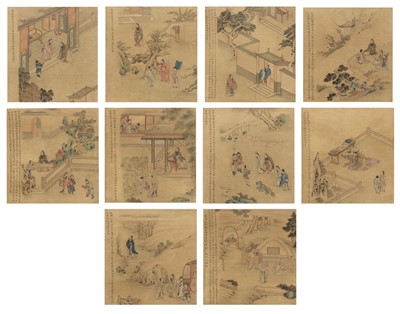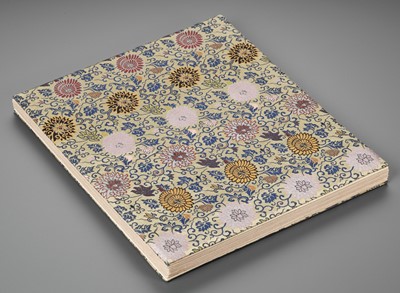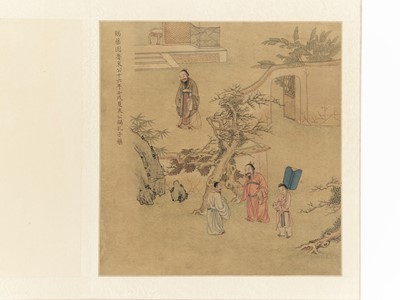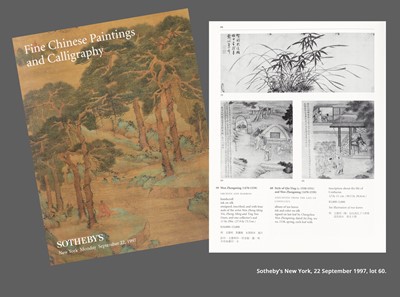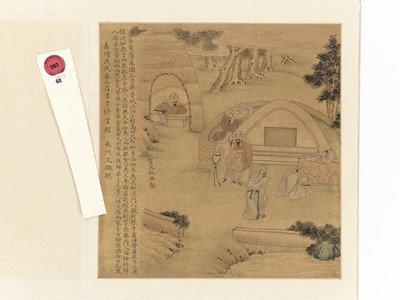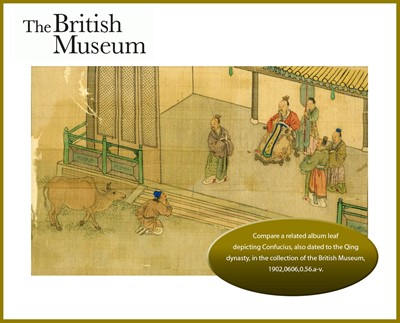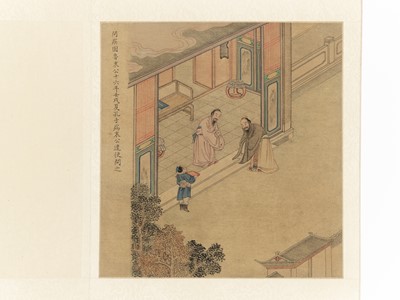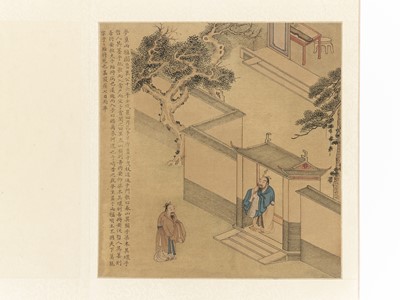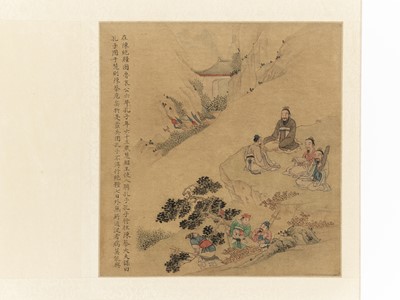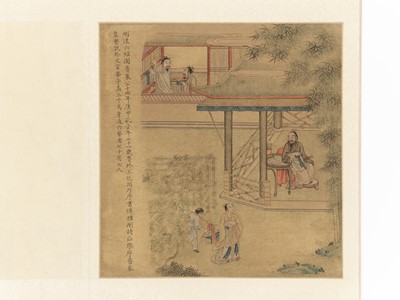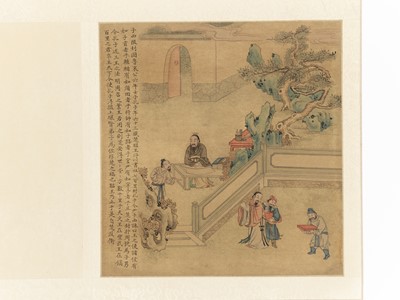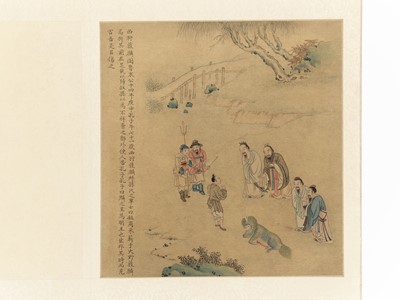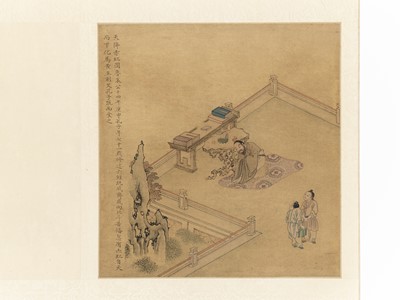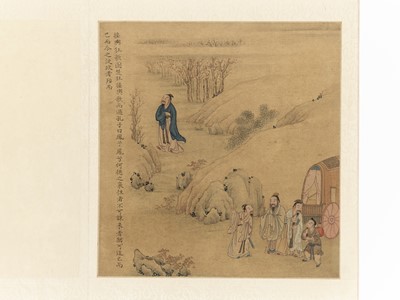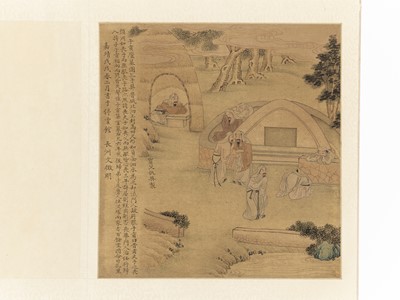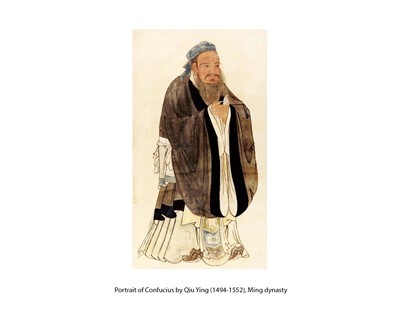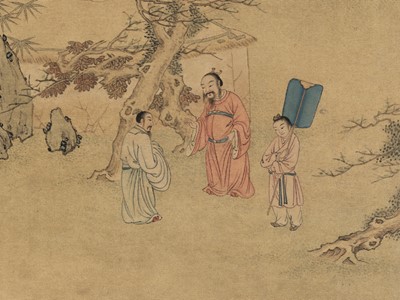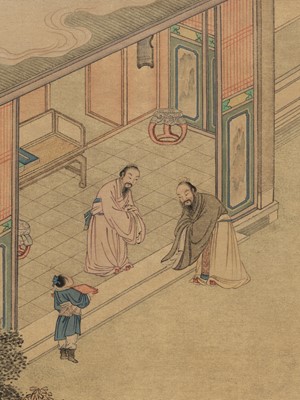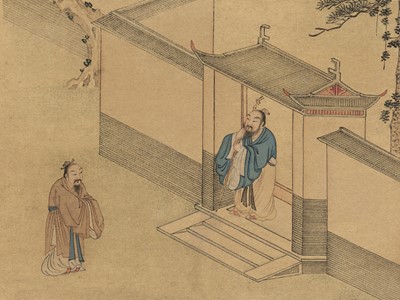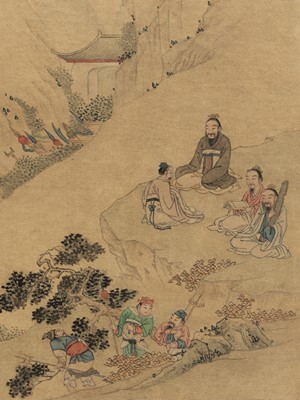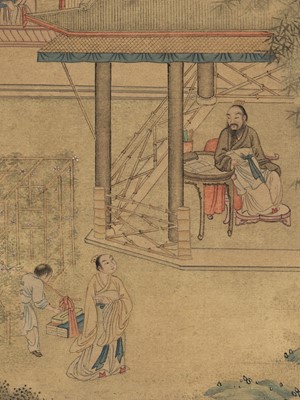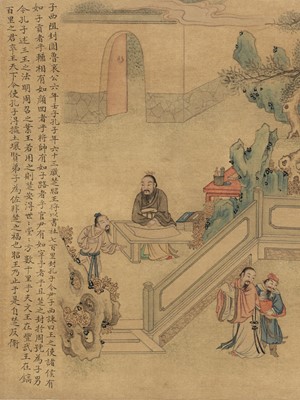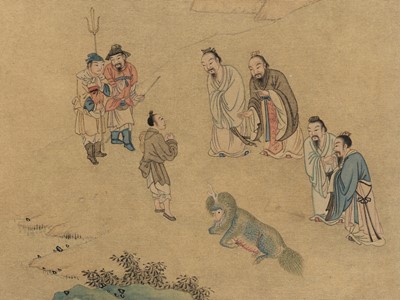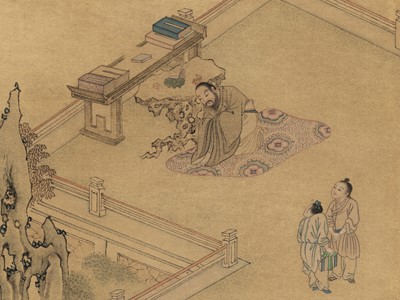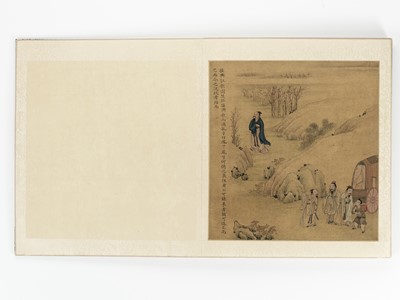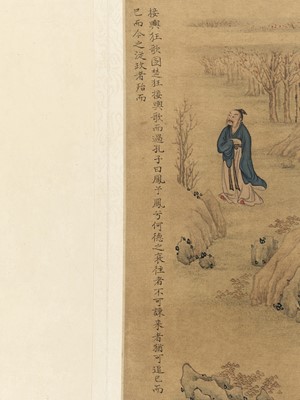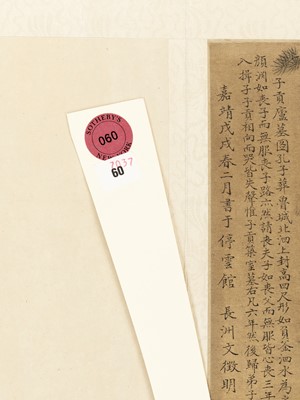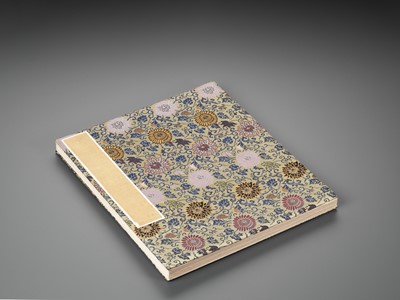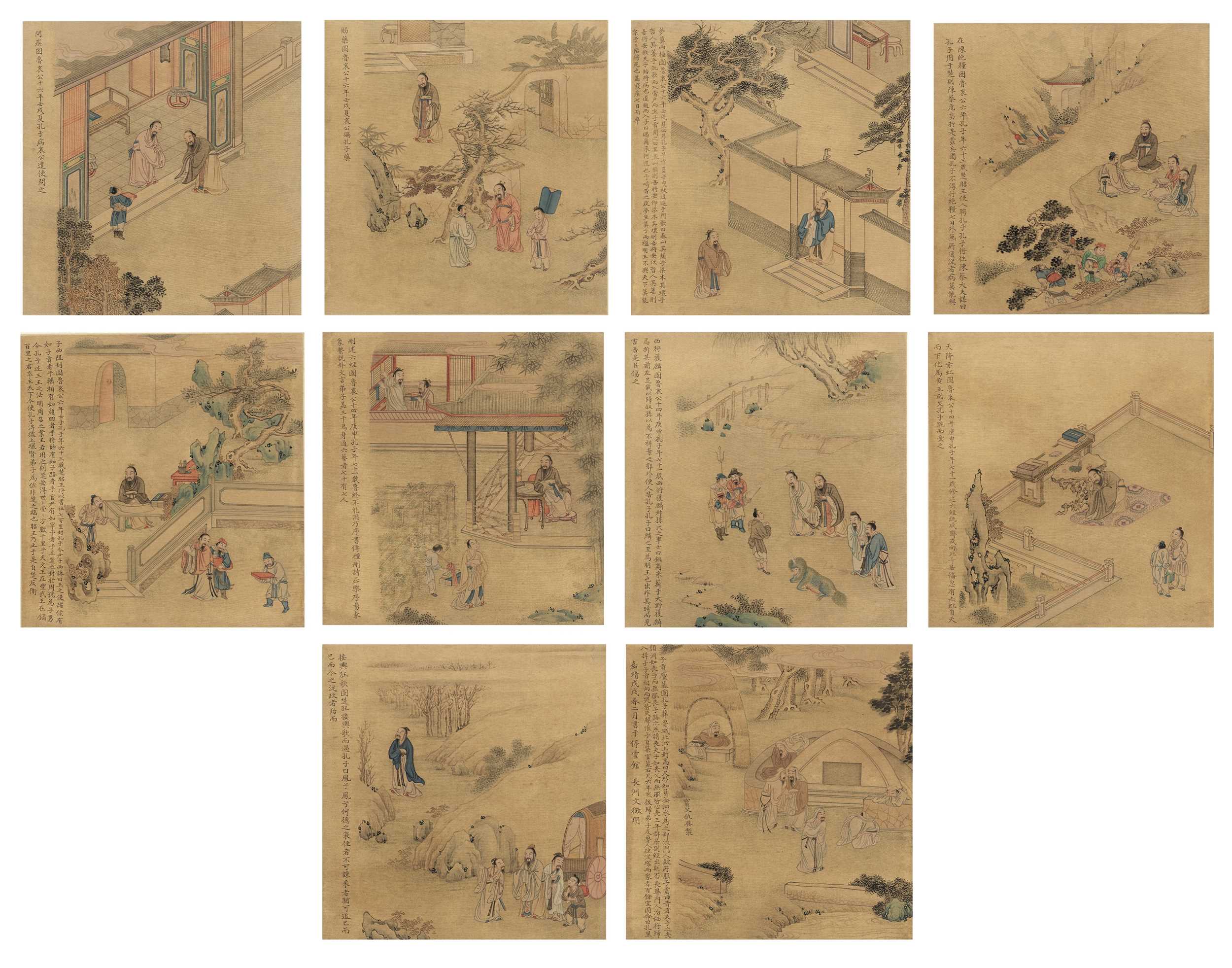11th Mar, 2022 10:00
DAY 2 - TWO-DAY AUCTION - Fine Chinese Art / 中國藝術集珍 / Buddhism & Hinduism
541
‘ANECDOTES FROM THE LIFE OF CONFUCIUS’, AFTER QIU YING (1494-1552) AND WEN ZHENGMING (1470-1559), QING DYNASTY
清代仿仇英與文徵明《孔子聖跡圖》冊頁
Sold for €8,848
including Buyer's Premium
China, 18th-19th century. Ink and watercolors on silk. Containing ten leaves. With various depictions of the legendary philosopher Confucius (551-479 BC), showing him seated with other scholars on a rock above a group of soldiers with further warriors hiding in the background, seated at a table examining a scroll in a palace terrace; relaxing in a pavilion; together with a qilin; kneeling in prayer; walking through a forest; and engaged in other pursuits. With silk brocade front and back covers.
Inscriptions: Signatures of Qiu Ying and Wen Zhengming. The final leaf dated ‘Jiajing wuxu’ (corresponding to 1538).
Provenance: Sotheby’s New York, 22 September 1997, lot 60. A private collector, acquired from the above, and thence by descent.
Condition: The leaves and front and back covers have come apart. Very good condition overall with only minor wear, little soiling and foxing, and few small losses.
Dimensions: Image size ca. 30.5 x 28.6 cm (each), Cover size 37.2 x 32.2 cm
The ten scenes presented in this album are titled and inscribed as follows:
- Visitation: When Confucius was ill, King Lu sent a messenger to visit him
- Presenting the Medicine: King Lu sent a messenger to deliver medicine to Confucius
- The Dream of Two Pillars: The student Zigong visited Confucius. Confucius told him that he dreamt of sitting between two pillars. A few days later, Confucius died.
- Hunger Strike in the Chen Empire: The King of Chu invited Confucius to his state. The King of Chen was afraid that Confucius would lend great strength to Chu and did not want to let him leave. Chen sent soldiers to Confucius, who went on hunger strike for seven days.
- Zixi hinders a bestowal to Confucius: The King of Chu wanted to bestow lands on Confucius. His prime minister Zixi did not believe it was a good decision and thwarted the bestowal.
- Writing the Six Classics: At the age of 71, Confucius completed the Six Classics.
- Capturing a Qilin during a Hunt: The King of Lu captured an unknown creature while hunting. Confucius was able to identify it and said it was an auspicious animal. Unfortunately the animal died of its injuries. Confucius died two years later.
- Red Rainbow from the Sky: One day a red rainbow descended from the sky and turned into yellow jade. Confucius kneeled before it.
- Grandiose Song by Jieyu from the Chu State: After Confucius’ arrival in the Chu state, Jieyu, an impartial resident of Chu, walked past his door and sang loudly.
- Zigong Tends to the Grave: After Confucius’ death, his student Zigong took care of his grave for six years.
Confucius (551-479 BC) was a Chinese philosopher, poet, and politician of the Spring and Autumn period who was traditionally considered the paragon of Chinese sages. Confucius’ teachings and philosophy formed the basis of East Asian culture and society, and continues to remain influential across China and East Asia as of today. His philosophical teachings, called Confucianism, emphasized personal and governmental morality, correctness of social relationships, justice, kindness, and sincerity. Confucianism was part of the Chinese social fabric and way of life. To Confucians, everyday life was the arena of religion. Confucius's principles have commonality with Chinese tradition and belief. With filial piety, he championed strong family loyalty, ancestor veneration, and respect of elders by their children and of husbands by their wives, recommending family as a basis for ideal government. He espoused the well-known principle "Do not do unto others what you do not want done to yourself", the Golden Rule.
Literature comparison: Compare a related album leaf depicting Confucius, also dated to the Qing dynasty, in the collection of the British Museum, 1902,0606,0.56.a-v.
清代仿仇英與文徵明《孔子聖跡圖》冊頁
中國,十八至十九世紀。絹本水墨設色。十頁,分別描繪了聖人孔子的歷史故事,其中有:問疾圖,賜藥圖,夢奠兩楹圖,在陳絕糧圖,子西阻封圖,刪述六經圖,西狩獲麟圖,天降赤紅圖,接興狂歌圖,子貢盧墓圖。冊頁,硬質封面封底,綾錦裝裱。
款識: 仇英,文徵明,嘉靖戊戌 (1538年)
來源:紐約蘇富比,1997年9月22日 lot 60;私人藏家,購於上述拍賣,保存至今。
品相:封面和封底與版心已經脫離,整體狀況極好,只有輕微磨損,少量污漬與小缺損。
尺寸:畫面30.5 x 28.6 厘米,封面 37.2 x 32.2 厘米
China, 18th-19th century. Ink and watercolors on silk. Containing ten leaves. With various depictions of the legendary philosopher Confucius (551-479 BC), showing him seated with other scholars on a rock above a group of soldiers with further warriors hiding in the background, seated at a table examining a scroll in a palace terrace; relaxing in a pavilion; together with a qilin; kneeling in prayer; walking through a forest; and engaged in other pursuits. With silk brocade front and back covers.
Inscriptions: Signatures of Qiu Ying and Wen Zhengming. The final leaf dated ‘Jiajing wuxu’ (corresponding to 1538).
Provenance: Sotheby’s New York, 22 September 1997, lot 60. A private collector, acquired from the above, and thence by descent.
Condition: The leaves and front and back covers have come apart. Very good condition overall with only minor wear, little soiling and foxing, and few small losses.
Dimensions: Image size ca. 30.5 x 28.6 cm (each), Cover size 37.2 x 32.2 cm
The ten scenes presented in this album are titled and inscribed as follows:
- Visitation: When Confucius was ill, King Lu sent a messenger to visit him
- Presenting the Medicine: King Lu sent a messenger to deliver medicine to Confucius
- The Dream of Two Pillars: The student Zigong visited Confucius. Confucius told him that he dreamt of sitting between two pillars. A few days later, Confucius died.
- Hunger Strike in the Chen Empire: The King of Chu invited Confucius to his state. The King of Chen was afraid that Confucius would lend great strength to Chu and did not want to let him leave. Chen sent soldiers to Confucius, who went on hunger strike for seven days.
- Zixi hinders a bestowal to Confucius: The King of Chu wanted to bestow lands on Confucius. His prime minister Zixi did not believe it was a good decision and thwarted the bestowal.
- Writing the Six Classics: At the age of 71, Confucius completed the Six Classics.
- Capturing a Qilin during a Hunt: The King of Lu captured an unknown creature while hunting. Confucius was able to identify it and said it was an auspicious animal. Unfortunately the animal died of its injuries. Confucius died two years later.
- Red Rainbow from the Sky: One day a red rainbow descended from the sky and turned into yellow jade. Confucius kneeled before it.
- Grandiose Song by Jieyu from the Chu State: After Confucius’ arrival in the Chu state, Jieyu, an impartial resident of Chu, walked past his door and sang loudly.
- Zigong Tends to the Grave: After Confucius’ death, his student Zigong took care of his grave for six years.
Confucius (551-479 BC) was a Chinese philosopher, poet, and politician of the Spring and Autumn period who was traditionally considered the paragon of Chinese sages. Confucius’ teachings and philosophy formed the basis of East Asian culture and society, and continues to remain influential across China and East Asia as of today. His philosophical teachings, called Confucianism, emphasized personal and governmental morality, correctness of social relationships, justice, kindness, and sincerity. Confucianism was part of the Chinese social fabric and way of life. To Confucians, everyday life was the arena of religion. Confucius's principles have commonality with Chinese tradition and belief. With filial piety, he championed strong family loyalty, ancestor veneration, and respect of elders by their children and of husbands by their wives, recommending family as a basis for ideal government. He espoused the well-known principle "Do not do unto others what you do not want done to yourself", the Golden Rule.
Literature comparison: Compare a related album leaf depicting Confucius, also dated to the Qing dynasty, in the collection of the British Museum, 1902,0606,0.56.a-v.
清代仿仇英與文徵明《孔子聖跡圖》冊頁
中國,十八至十九世紀。絹本水墨設色。十頁,分別描繪了聖人孔子的歷史故事,其中有:問疾圖,賜藥圖,夢奠兩楹圖,在陳絕糧圖,子西阻封圖,刪述六經圖,西狩獲麟圖,天降赤紅圖,接興狂歌圖,子貢盧墓圖。冊頁,硬質封面封底,綾錦裝裱。
款識: 仇英,文徵明,嘉靖戊戌 (1538年)
來源:紐約蘇富比,1997年9月22日 lot 60;私人藏家,購於上述拍賣,保存至今。
品相:封面和封底與版心已經脫離,整體狀況極好,只有輕微磨損,少量污漬與小缺損。
尺寸:畫面30.5 x 28.6 厘米,封面 37.2 x 32.2 厘米
Zacke Live Online Bidding
Our online bidding platform makes it easier than ever to bid in our auctions! When you bid through our website, you can take advantage of our premium buyer's terms without incurring any additional online bidding surcharges.
To bid live online, you'll need to create an online account. Once your account is created and your identity is verified, you can register to bid in an auction up to 12 hours before the auction begins.
Intended Spend and Bid Limits
When you register to bid in an online auction, you will need to share your intended maximum spending budget for the auction. We will then review your intended spend and set a bid limit for you. Once you have pre-registered for a live online auction, you can see your intended spend and bid limit by going to 'Account Settings' and clicking on 'Live Bidding Registrations'.
Your bid limit will be the maximum amount you can bid during the auction. Your bid limit is for the hammer price and is not affected by the buyer’s premium and VAT. For example, if you have a bid limit of €1,000 and place two winning bids for €300 and €200, then you will only be able to bid €500 for the rest of the auction. If you try to place a bid that is higher than €500, you will not be able to do so.
Online Absentee and Telephone Bids
You can now leave absentee and telephone bids on our website!
Absentee Bidding
Once you've created an account and your identity is verified, you can leave your absentee bid directly on the lot page. We will contact you when your bids have been confirmed.
Telephone Bidding
Once you've created an account and your identity is verified, you can leave telephone bids online. We will contact you when your bids have been confirmed.
Classic Absentee and Telephone Bidding Form
You can still submit absentee and telephone bids by email or fax if you prefer. Simply fill out the Absentee Bidding/Telephone bidding form and return it to us by email at office@zacke.at or by fax at +43 (1) 532 04 52 20. You can download the PDF from our Upcoming Auctions page.
How-To Guides
How to Create Your Personal Zacke Account
How to Register to Bid on Zacke Live
How to Leave Absentee Bids Online
How to Leave Telephone Bids Online
中文版本的操作指南
创建新账号
注册Zacke Live在线直播竞拍(免平台费)
缺席投标和电话投标
Third-Party Bidding
We partner with best-in-class third-party partners to make it easy for you to bid online in the channel of your choice. Please note that if you bid with one of our third-party online partners, then there will be a live bidding surcharge on top of your final purchase price. You can find all of our fees here. Here's a full list of our third-party partners:
- 51 Bid Live
- EpaiLive
- ArtFoxLive
- Invaluable
- LiveAuctioneers
- the-saleroom
- lot-tissimo
- Drouot
Please note that we place different auctions on different platforms. For example, in general, we only place Chinese art auctions on 51 Bid Live.
Bidding in Person
You must register to bid in person and will be assigned a paddle at the auction. Please contact us at office@zacke.at or +43 (1) 532 04 52 for the latest local health and safety guidelines.
